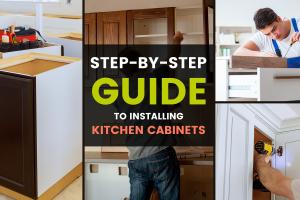Ultimate Guide to Installing Kitchen Cabinets: Step-by-Step Instructions

-
Quick Links:
- Introduction
- Planning Your Kitchen Cabinet Installation
- Essential Tools and Materials
- Removing Old Cabinets
- Installing Base Cabinets
- Installing Wall Cabinets
- Finishing Touches
- Case Studies and Examples
- Expert Tips for Success
- FAQs
Introduction
Installing kitchen cabinets can seem like a daunting task, but with the right preparation and guidance, it can be a gratifying DIY project that transforms your kitchen. This comprehensive guide will walk you through the entire process, from planning and removing old cabinets to installing new ones and adding finishing touches. Whether you're a seasoned DIYer or a novice, our step-by-step instructions, expert insights, and real-world examples will help you achieve a successful installation.
Planning Your Kitchen Cabinet Installation
Before diving into the installation process, it's crucial to plan carefully. Here are the steps you should take:
- Design your kitchen layout: Use design software or graph paper to visualize the layout.
- Measure your space: Accurate measurements will help you avoid costly mistakes.
- Choose your cabinets: Decide on the style, material, and finish that suits your taste.
- Budgeting: Set a budget that includes cabinets, tools, and any additional materials.
Essential Tools and Materials
Having the right tools and materials is essential for a successful installation. Here’s a list of what you’ll need:
- Power drill
- Level
- Stud finder
- Measuring tape
- Hammer
- Screwdriver
- Clamps
- Cabinet screws
- Wood shims
- Safety goggles
Removing Old Cabinets
Before you can install new cabinets, you must remove the old ones. Follow these steps:
- Empty the cabinets: Remove all items from the cabinets and countertops.
- Turn off power: If your cabinets have lighting, turn off the power at the circuit breaker.
- Remove cabinet doors: Unscrew the hinges and take off the doors.
- Detach the cabinets: Use a drill to remove screws holding the cabinets to the wall and each other.
- Disposal: Dispose of the old cabinets responsibly—donate or recycle if possible.
Installing Base Cabinets
Base cabinets provide the foundation for your kitchen. Here’s how to install them:
- Locate the highest point: Use a level to find the highest point on your floor.
- Mark a level line: Draw a level line around the perimeter of the kitchen, using the highest point as your reference.
- Set the first cabinet: Place the first base cabinet against the wall and ensure it's level.
- Secure the cabinet: Use screws to attach it to the wall and connect to adjoining cabinets.
- Fill gaps: Use wood shims to adjust the height and fill any gaps between cabinets.
Installing Wall Cabinets
After the base cabinets are in place, it’s time to install the wall cabinets:
- Measure and mark: Measure the height for your wall cabinets and mark a level line.
- Locate studs: Use a stud finder to locate studs in the wall.
- Hang the first cabinet: Lift the cabinet into place and secure it to the wall, ensuring it’s level.
- Connect cabinets: Secure adjoining wall cabinets together.
- Check alignment: Continuously check for level as you work.
Finishing Touches
Once all cabinets are installed, it’s time for the finishing touches:
- Install cabinet doors: Reattach doors and adjust hinges as necessary.
- Add hardware: Install knobs and handles for a polished look.
- Caulk and paint: Fill in any gaps with caulk and touch up paint as needed.
Case Studies and Examples
Let’s look at a couple of case studies that showcase different approaches to kitchen cabinet installation:
Case Study 1: A homeowner with a small kitchen maximized space by installing vertically stacked cabinets. They used a combination of open shelves and closed cabinets to maintain an airy feel while maximizing storage.
Case Study 2: A DIY enthusiast revamped their outdated kitchen with a budget-friendly cabinet refacing project, opting for a fresh coat of paint and new hardware instead of full replacement.
Expert Tips for Success
Here are some expert tips to ensure your cabinet installation goes smoothly:
- Work with a partner to lift and secure heavy cabinets.
- Always double-check your measurements before making cuts or drilling holes.
- Consider using a professional if you're unsure about structural integrity or plumbing.
FAQs
1. How long does it take to install kitchen cabinets?
The time can vary greatly, but a typical kitchen installation can take 1-3 days depending on the size and complexity.
2. Do I need to hire a professional to install cabinets?
If you're comfortable with DIY projects and have basic skills, you can install cabinets yourself. However, hiring a pro may save time and ensure quality.
3. What tools do I need for cabinet installation?
Essential tools include a power drill, level, stud finder, measuring tape, and a screwdriver.
4. Can I install cabinets on my own?
Yes, many homeowners successfully install cabinets themselves with proper planning and preparation.
5. What type of cabinets are best for kitchens?
It depends on your style and needs, but solid wood and plywood cabinets are often recommended for durability.
6. How do I ensure my cabinets are level?
Use a level tool throughout the installation process and adjust with shims as needed.
7. Can I install cabinets without help?
While it’s possible, having a partner can make the process easier and safer, especially for heavier cabinets.
8. What is the best way to remove old cabinets?
Follow a systematic approach: clear out contents, disconnect utilities, and carefully unscrew from the wall.
9. How do I maintain my kitchen cabinets after installation?
Regular cleaning with mild soap and water and avoiding harsh chemicals will help maintain your cabinets.
10. What if my walls are uneven?
Use shims to level cabinets during installation and consider adjusting the design to accommodate the walls.
Random Reads